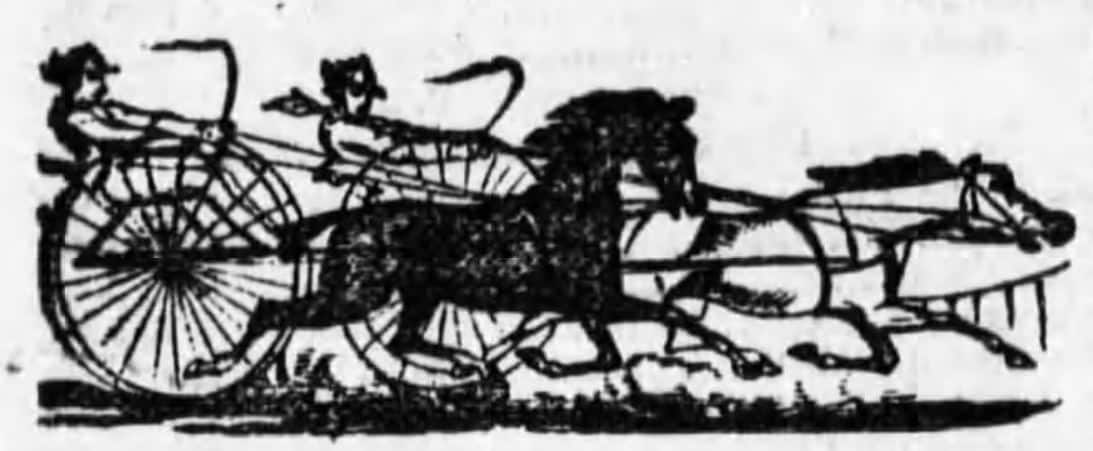Noblesville’s Miracle Horse – Longfellow Whip
By: David Heighway, Hamilton County Historian
People love stories like the one for the racehorse Seabiscuit, particularly when the horse’s greatness is unsuspected. Noblesville was the home for one such horse, although his story might have been exaggerated by the press. He was a harness racing horse that pulled a sulky rather than a riding horse like Seabuscuit and was a trotter. (I apologize in advance for any errors in describing horse breeding and trotting races.)

In 1877, a horse was born in the stable of William John Martin, a Noblesville wagon maker, who decided to name the colt Longfellow Whip. The colt’s father was a noted Morgan trotting horse named Kentucky Whip. Kentucky Whip had something of a questionable history – his owner had been in trouble with the law and didn’t want people tracking his activities. The colt’s mother (dam) was Bessie Brown, sometimes called Miss Martin.
W.J. Martin didn’t start racing Longfellow Whip until 1883, and that’s when the possible exaggeration or “fake news” starts. The stories are mostly about Longfellow’s mother, Bessie Brown. She was a locally raised horse, which Martin had purchased from Nathan Clover. She was described as being “of Morgan appearance”, but her pedigree was unknown. She was the mother to other successful colts.
The stories started in an article in the September 10, 1883, issue of the Indianapolis News titled “A New and Phenomenal Horse”. This article said that Martin had “reluctantly accepted an old mare in payment for some work done” and that this “unpromising nag” had given birth to the colt. He later sold the mare for $100 and when the colt was old enough, had used it for daily driving. He felt the horse had potential and decided to race in the county fair, but was “hooted out”.
Instead he entered the races at the fair in New Ross, Indiana, on August 14-17 and took home a $300 prize. The Hamilton County Fair was held on August 27-31 at the new fairgrounds built by Ezra Swain, (where Riverview Hospital is today), with a half mile track. No one else had entered the race, so the judge said that if Martin could trot a mile in under 2 minutes and 30 seconds, he would get the prize money. The Richmond Item newspaper reported that the horse did it in 2 minutes and 21 seconds “without exerting himself in the least” and did the last quarter mile at 33 seconds. Other papers reported the time as 2:24.

This was a huge success, and Martin was immediately offered $5000 for the horse. The article claimed that Martin took no special care of it. He allegedly stabled it in old shed, and didn’t sponge it down after use, instead tying it to a fence post to cool off. (This seems unlikely, as it would have been considered cruelty by other breeders and would have lowered the value of the horse.) The article then claimed that Martin’s horse could beat another local favorite, Hambrino, owned by Marcus L. Hare, (who I will cover in a future post). Interestingly, Longfellow Whip is never named in the article.
The story was picked up by newspapers around Indiana, and in Kentucky, Minnesota, Pennsylvania, Nevada, and California. The story grew as it traveled. One Indianapolis paper said, among other things, that the horse was just “picked up in some farm yard”, which the Noblesville Republican-Ledger called “a conglomeration of misstatements”.
Martin continued to race Longfellow Whip around the area, going to Lafayette on September 5 ($300 prize), Crawfordsville on September 15 (2nd place), Indianapolis on September 28 (3rd place), and Chicago on October 10 (last place). Despite the poor showing, the horse was still regarded as successful and was sold for $5000 in February 1884 to J. D. Speers of Peoria, Illinois. Speers continued to race Longfellow Whip all over the Midwest and, in 1889, the horse did a mile in 2 minutes and 12 seconds. He was retired to a stud farm that year. A livestock breeders’ journal, Wallace’s Monthly, did a short article on Longfellow Whip in August of 1889, which looked at his career and the mystery behind his father and called him “continuous and stubborn campaigner”.
According to the 1894 Morgan Horse Register, Longfellow Whip was brown with a tan muzzle and flanks, 15 ¾ hands high, and 1100 pounds. He had had run 79 races and won 22 of them; did 296 heats, won 81 of them with 51 under 2 minutes and 30 seconds. W. J. Martin was quoted as saying: “Longfellow Whip was of a kind and affectionate disposition, with great courage and speed; while I owned him he trotted quarters in 33 seconds and a half in 1:08. He was handsome and stylish, with the best of feet and legs.”
I haven’t been able to find when Longfellow Whip died. He’s mentioned in a poem called “Those Old High Wheels” In the book “Heart Throbs and Hoof Beats: Poems of Track, Stable, and Fireside” published in 1922. William John Martin had moved to Hanford, California, where he used his wagon making skill to build the first fire engine in the city. If this photo is a clue, he probably continued to do horse breeding. To get a sense of the size of the horse in the photo, Martin was five feet, six inches tall. He died sometime between 1894 and 1900.
